The Cenotes
The Riviera Maya is home to the largest underground river system in the world.
Thousands of years ago this underground river system hollowed out huge underwater caves and created amazing rock formations. As the caves grew larger some of them started to collapse and gateways to the river system were opened. These sinkholes are called Cenotes. The word "Cenote" is derived from the Mayan term "D'zonot", which represents a subterranean cavity that contains permanent water. The Mayan people considered the Cenotes as the entrance to their mythical and spiritual underworld and also they were their only fresh water source in the middle of the jungle.
Today the Cenotes provide some of the most amazing diving experiences in the world. Glide though the caverns enjoying endless visibility, other-worldly views of stalactites and stalagmites, beams of light filtering through the jungle above and rock formations beyond your imagination.
To ensure maximum safety and fun we maintain a maximum of four divers per cavern guide.
Our daily Cenote diving trips depart from the dive center, taking you to Cenotes like the famous Dos Ojos (Two Eyes) or Chac-Mool.
Passing through the dense Mayan jungle we make our way to the first site where an elaborate briefing by our specialized cavern guide will be given.
Diving through this wonderland of stalactites, stalagmites, large caverns and light shows you are guaranteed an experience of a lifetime.
Between the two dives we will have a light lunch and we will be back to Playa del Carmen at around 15:00.
Due to excellent conditions, shallow depth, endless visibility, spacious caverns and little current, the Cenote dives are fit for all levels of certified divers.
Trips include tanks, weights, transportation, entrance fee, light lunch, multilingual guide and a guaranteed smile upon return!!
Don’t miss out on the best dives of the Riviera Maya!!
Click here to view our Cenotes photo gallery >> Cenotes Cenotes Cenotes Cenotes Cenotes Cenotes Cenotes Cenotes Cenotes Cenotes Cenotes Cenotes Cenotes Cenotes Cenotes Cenotes Cenotes Cenotes cenotes diving
Daily8:15 to 15:00
Open Water Diver or Equivalent
Dive Sites

Chac-Mool
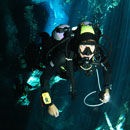
Chac-Mool is located 16km/10miles south of Playa del Carmen. The first room is relatively big and has a lot of light entering from the opening. In the second room, part of the ceiling has collapsed under an air dome where divers can surface. Through the opening of the main entrance divers can experience a spectacular laser light show on sunny days. Chac-Mool also presents you with another phenomenon, the halocline. With its large rooms and shallow waters this Cenote is perfect for beginners to cavern diving.
12m/36ftPonderosa
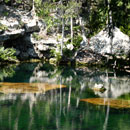
Located 25km/16miles south of Playa, this Cenote presents big rocks covered by plants on the bottom and is home to a variety of fresh water fish and eels. It is a perfect place for swimmers and snorkelers, and is also a common spot for diving courses when the ocean is too rough. The cave has very large rooms and several daylight entrances and is qualified as easy, making it perfect for not so experienced divers.
14m/42ftTaj-Mahal
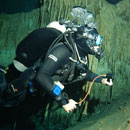
Taj-Mahal is located 26km/16miles south of Playa del Carmen. This Cenote is part of the same cavern system than Chac-Mool. On sunny days you may be witness to a spectacular light show. In the center of the Cenote is a hole with a diameter of 10m/30ft, which is located in the heart of the jungle where divers can surface to admire the beautiful Mexican jungle.
14m/42ftDos Ojos
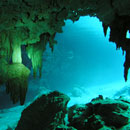
Dos Ojos is located 48km/30miles south of Playa del Carmen. It got the name "Dos Ojos" because it has two entrances or two eyes. The first eye, which is the first dive, starts at 10m/30ft and you dive the right side of the cavern. Exactly in the middle of this dive you'll find a plastic crocodile, which is used as a sign, and following the 1/3 rule, if you don't reach this point with 2/3 of your tank remaining, then it is mandatory you turn around and finish the dive. The second eye is much more delicate than the first section due to the amount of fragile stalactites and stalagmites so a good buoyancy control is highly recommended in order to not disturb the environment.
12m/36ftGran Cenote
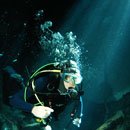
Located 3km/2miles east from Tulum, it is one of the most beautiful sights in the area, perfect for snorkeling. This Cenote is perfect for non-experienced divers because of the immense amount of light, which penetrates the entire Cenote. This Cenote has plenty of rooms filled with stalactites for divers to admire.
10m/30ftAngelita
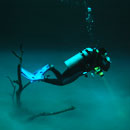
Located 17km/11miles south of Tulum, Angelita is the farthest Cenote from Playa del Carmen. After a 5 minutes walk into the jungle you will reach the circular shaped Cenote which looks pretty unremarkable. However, there is a spectacular change of views once you start descending. After a cloud of hydrogen sulfate you will get to the saltwater which is very dark, giving you the sensation of being in the middle of a forest at night. Because the maximum depth is 60m/180ft, it is only recommended for technical divers who have experience with decompression diving.
60m/180ftSafe Cavern Diving
Cavern diving has risks and limitations and cannot be considered as an open water dive: cavern diving means to dive into an overhead environment where it is not always possible to ascend to the surface as you can do during ocean dives.
When cavern diving we stay in the limits of the sunlight with a maximum penetration of 60m/180ft linear from the opening. Most Cenotes have a permanent installed rope, which serves as a guideline and great psychological reference. If there's no permanent guideline, the guide will install a temporarily one during the cavern tour. When a diver enters the cavern zone the air supply must be managed and it is imperative that he/she allows enough air to exit and plans for any unseen emergency. We respect the classic 1/3 rule, which has been an established procedure since the early 1970's.
Cavern diving demands that all divers exit the dive with a minimum of 1200psi/80bar, NO LESS.
Most Cenotes have an outstanding visibility up to 100m/300ft, and a water temperature of around 26ºC/78ºF, which can vary depending on weather conditions.
You can find the typical fresh water life, but the main idea of diving the Cenotes is to admire their amazing stalactites, stalagmites and the many rock formations that can easily make you think that you are somewhere in outer space.


